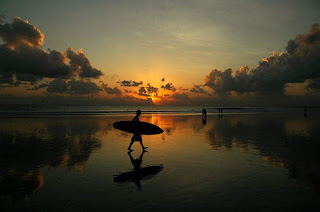Bali is overflowing with all types of accommodation – beautiful tropical villas, luxurious resorts, private cottages and small low-rate hotels. One of the top rated places to stay on the island is Hotel Como Shambhala Estate located in Ubud. The posh residence features elegantly-designed interiors, swanky rooms overlooking picturesque gardens, high-class furnishing, and extra spa treatments and yoga classes. Another top-line tourist site is the St. Regis Bali Resort offering utmost relaxation in a combination of modern design and antique influence. The impressive accommodation spoiles guests in a restaurant, a bar, a hairdressing saloon and exclusive apartments looking over colorful gardens. Bvlgari Hotel is another sparking lodging, displaying a stunning collection of Balinese antiques and beautifully-designed artistic ornaments, so it is a grand resort complex suitable to both business and leisure travelers.
Bali offers a wide variety of cheap holiday packages and great lodging deals, all providing cautious and friendly services. One of the preferred budget hotels in Bali is Bali Lovina Beach Cottages. The tranquil vacation place is located amidst a lush tropical garden, right in front of the picturesque Lovina Beach and offering excellent facilities for swimming, snorkeling and diving. Another comfortable accommodation for budget-minded travelers is Ida Hotel. The boutique lodging boasts a great range of amenities and services including a dining place serving traditional Indonesian cuisine, a huge pool with Jacuzzi and a pool-side massage parlor. Sorga Cottages are located only a short distance to the popular Kuta Beach and tender calm and private holiday atmosphere, modern facilities and luxuriously designed rooms – everything at affordable prices!
The island of Bali is a place where tourists can spot the magnitude even in the air of the enchanting place – it is saturated with calmness, quietness and wisdom. Along with exquisite hotels and beach resorts, this Indonesian holiday destination is abundant in tropical plants and rare trees. The fragrance of the variety of blooming flowers is everywhere – hibiscus, jasmine, orchids and magnolia scents fill every street of the holy place. Hundreds of diverse bird and animal species find their home on the island. The sightseeing options are immense – the active mall volcano of Mount Batur, the amazing waterfall at Gitgit, the Mandala Garuda Wisnu Kencana Cultural Park, the Reptile Park sheltering a great number of snakes, lizards and crocodile are only a few of the "must see" landmarks in Bali.
Bali offers a wide variety of cheap holiday packages and great lodging deals, all providing cautious and friendly services. One of the preferred budget hotels in Bali is Bali Lovina Beach Cottages. The tranquil vacation place is located amidst a lush tropical garden, right in front of the picturesque Lovina Beach and offering excellent facilities for swimming, snorkeling and diving. Another comfortable accommodation for budget-minded travelers is Ida Hotel. The boutique lodging boasts a great range of amenities and services including a dining place serving traditional Indonesian cuisine, a huge pool with Jacuzzi and a pool-side massage parlor. Sorga Cottages are located only a short distance to the popular Kuta Beach and tender calm and private holiday atmosphere, modern facilities and luxuriously designed rooms – everything at affordable prices!
The island of Bali is a place where tourists can spot the magnitude even in the air of the enchanting place – it is saturated with calmness, quietness and wisdom. Along with exquisite hotels and beach resorts, this Indonesian holiday destination is abundant in tropical plants and rare trees. The fragrance of the variety of blooming flowers is everywhere – hibiscus, jasmine, orchids and magnolia scents fill every street of the holy place. Hundreds of diverse bird and animal species find their home on the island. The sightseeing options are immense – the active mall volcano of Mount Batur, the amazing waterfall at Gitgit, the Mandala Garuda Wisnu Kencana Cultural Park, the Reptile Park sheltering a great number of snakes, lizards and crocodile are only a few of the "must see" landmarks in Bali.

 11/17/2011
11/17/2011
 Mr. PH
Mr. PH

 Posted in:
Posted in: 














































